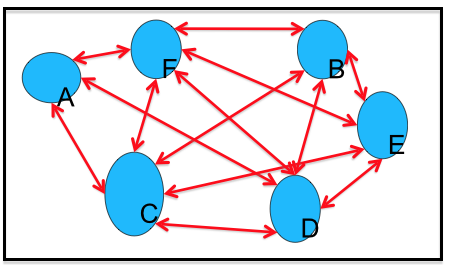 How do we manage an organization to cope with complexity? It means understanding the organization as a system and seeing the interdependencies, something that the Patriots understand.
How do we manage an organization to cope with complexity? It means understanding the organization as a system and seeing the interdependencies, something that the Patriots understand.
Independence vs. interdependence
What can the theory of systems tell us about managing organizations? First of all, if all the components that make up the system are independent, then the maximum result that the system can produce is simply the sum of the efforts of each component. A good example of that would be a bowling team.
 On the other hand, if the components of the system are interdependent, then the maximum result that the system can produce is all about the interactions among the parts ( see the red lines in the image below).
On the other hand, if the components of the system are interdependent, then the maximum result that the system can produce is all about the interactions among the parts ( see the red lines in the image below).
In this situation, it would be completely inappropriate to think that the sum of the parts is the whole. Instead, the way the components interdepend and interact is what determines the end result. A good example of this would be a football team, and the success of the Patriots is largely based on their understanding of this phenomenon.
Managing an organization through interdependencies
What does this mean when it comes to managing organizations? It changes everything. This is because the interactions among the components are not linear. Something new emerges form these interactions, and this is the reality we have to manage. How do we do that?
A systemic approach to the economics and management of resources in an organization looks at interdependencies. It focuses on what can be achieved by combining the resources at hand. This requires synchronization.
The goal of synchronization is to make the most out of what we have as a system. The cognitive ordeal that we face in embracing such a model is that the resources do not “belong” to something; they cannot be allocated in any conventional “functional” way. Achieving a systemic optimum is a very different sport from achieving a set of functional optima. Everything has to be subordinated to the constraint of the system. In fact, in the systemic game, resources are generally sub-optimized locally in order to optimize the global systemic result.
The Playbook
This may sound strange and new to some people, but it’s actually a much more natural way of organizing resources than forcing them into artificial silos and functions. How do we operationally reinforce synchronization within our system? When we build our organization as a systemic structure , one of the vital components to keep the structure alive and working is what we can call the Playbook. This is a detailed map of all our processes and the repository of all the knowledge needed to operate the interdependencies.
A playbook is built by mapping out in detail all the interactions that lead to the goal of the system. This can be achieved with Deployment Flow Charts and this mapping process alone can lead to significant improvements in the way processes are carried out. When you manage the interdependencies in your organization you create the possibility for something much mightier than a bowling team. You free up the possibility for the organization to improve its performance as a whole.
We will take a further look at synchronizing processes in our next post.
Coming this month! Our new business novel The Human Constraint is an e-book that takes the reader on a roller-coaster ride through the financial crisis and towards a new model for future business. The e-book comes with an accompanying website highlighting chapter by chapter the thinking, methods and tools to achieve a new economy of sustainable wealth.







Dear Angela:
I always find your views very enlightening. The example of the bowling team is great.
Regarding subordination: it is my opinion that the system must not subordinate to its constraint. Systems must subordinate to its largest leverage points.